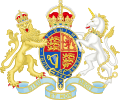List of ambassadors of the United Kingdom to the United States facts for kids
Quick facts for kids His Britannic Majesty’s Ambassador to the United States of America |
|
|---|---|

|
|
| Foreign and Commonwealth Office British Embassy, Washington D.C. |
|
| Style | Her Excellency Madam Ambassador |
| Reports to | Secretary of State for Foreign and Commonwealth Affairs |
| Residence | British Ambassador's Residence, Washington, D.C. |
| Appointer | The King on advice of the Prime Minister of the United Kingdom |
| Term length | At His Majesty's pleasure |
| Inaugural holder | George Hammond First Envoy Extraordinary to US |
| Formation | 1791 |
| Website | British Embassy – Washington |
The British Ambassador to the United States is a very important person. They are in charge of the British Embassy in Washington, D.C.. This embassy is the main way the United Kingdom talks to the United States. The ambassador's full title is His Britannic Majesty's Ambassador to the United States of America.
The ambassador lives in a special house in Washington, D.C. It is on Massachusetts Avenue. A famous architect named Sir Edwin Lutyens designed the house. It was built in 1928.
Contents
What Does an Ambassador Do?
Being the ambassador to the United States is one of the most important jobs for a British diplomat. It is a top role in His Majesty's Diplomatic Service.
The ambassador's main job is to explain the UK's ideas and plans to the American government and people. They also tell the Government of the United Kingdom what the American government thinks. They are the main way the two countries communicate. They also help make important agreements between the two nations.
The ambassador is also in charge of helping British citizens in the United States. This includes helping with visas for people who want to visit the UK. They also make sure British people living or traveling in America get help if they need it. Plus, they help build good cultural connections between the two countries.
A Look at History
The first official British representative in the United States was Sir John Temple. He was appointed in 1785. He worked from New York.
In 1791, George Hammond became the first "Minister to the United States of America." At first, the US was a republic, so countries sent "ministers" instead of "ambassadors." This was a slightly lower rank.
In 1809, David Erskine, a British minister, tried to solve problems between the UK and the US. These problems were about ships in the Atlantic Ocean. His efforts might have stopped the War of 1812. However, King George III and the British government did not agree with the deal. Erskine was called back to the UK.
By the 1850s, the British representative was called an "Envoy Extraordinary and Minister Plenipotentiary." This was still a "minister" role. Around this time, British officials tried to get Americans to join the Crimean War. The American government did not like this. President Franklin Pierce asked for the British minister, Sir John Crampton, to be removed. The UK refused, so the US government sent Crampton away in 1856. After many talks, the UK was allowed to send a new minister the next year.
In 1893, the British office in Washington became an Embassy. This meant the representative was now an "Ambassador." Sir Julian Pauncefote became the first British Ambassador to the United States.
It's interesting to know that this important job has been offered to three former British Prime Ministers. These were the Earl of Rosebery, David Lloyd George, and Sir Edward Heath. All of them chose not to take the job.
Who Has Been the Ambassador?
Over the years, many people have held this important role. Here are some of the people who have served as the British Ambassador to the United States:
- 1893–1902: Sir Julian Pauncefote (became Lord Pauncefote in 1899)
- 1902–1903: Hon. Sir Michael Herbert
- 1903–1906: Sir Mortimer Durand
- 1907–1913: James Bryce
- 1913–1918: Sir Cecil Spring Rice
- 1918–1919: The Earl of Reading
- 1919–1920: Viscount Grey of Fallodon
- 1920–1924: Sir Auckland Geddes
- 1924–1930: Sir Esme Howard
- 1930–1939: Sir Ronald Lindsay
- 1939–1940: The Marquess of Lothian
- 1940–1946: Viscount Halifax (became Earl of Halifax in 1944)
- 1946–1948: Lord Inverchapel
- 1948–1952: Sir Oliver Franks
- 1953–1956: Sir Roger Makins
- 1956–1961: Sir Harold Caccia
- 1961–1965: Hon. Sir David Ormsby-Gore (became Lord Harlech in 1964)
- 1965–1969: Sir Patrick Dean
- 1969–1971: Rt. Hon. John Freeman
- 1971–1974: The Earl of Cromer
- 1974–1977: Hon. Sir Peter Ramsbotham
- 1977–1979: Hon. Peter Jay
- 1979–1982: Sir Nicholas Henderson
- 1982–1986: Sir Oliver Wright
- 1986–1991: Sir Antony Acland
- 1991–1995: Sir Robin Renwick
- 1995–1997: Sir John Kerr
- 1997–2003: Sir Christopher Meyer
- 2003–2007: Sir David Manning
- 2007–2012: Sir Nigel Sheinwald
- 2012–2016: Sir Peter Westmacott
- 2016–2019: Lord Darroch of Kew
- 2020–present: Dame Karen Pierce
Ambassadors in Books and TV
Sometimes, ambassadors appear as characters in stories. Here are a few examples:
- Sir Everard Everett, in Wodehouse's book Jeeves and the Feudal Spirit.
- Lord John Marbury, in the TV show The West Wing on NBC.
- Sir Mark Brydon, in the BBC show The State Within.
See Also
- United States Ambassador to the United Kingdom
- Canadian ambassadors to the United States – This role became important for Canada after 1926.


